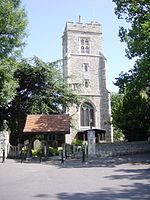M4 bus lane

The M4 bus lane was a 3.5-mile (5.6 km) bus lane on the eastbound (London-bound) carriageway of the M4 motorway between Heathrow Airport and central London. It operated between junction 3 (A312) to the start of the elevated 2-lane section near Brentford. The lane, which had no intermediate junctions, was reserved for buses, coaches, motorbikes, emergency vehicles and licensed taxis (but not minicabs).It was positioned in Lane 3 on the motorway, causing bus drivers to switch lanes between 1 mile and 500 yards before the lane started. The lane opened as a pilot in June 1999 and was made permanent in 2001. It was suspended during December 2010 using an 18-month Experimental Traffic Order after which it was reinstated temporarily for the 2012 London Olympics. It has since been scrapped permanently.
Excerpt from the Wikipedia article M4 bus lane (License: CC BY-SA 3.0, Authors, Images).M4 bus lane
M4, London Heston (London Borough of Hounslow)
Geographical coordinates (GPS) Address Nearby Places Show on map
Geographical coordinates (GPS)
| Latitude | Longitude |
|---|---|
| N 51.49257 ° | E -0.3598 ° |
Address
M4
TW5 0RP London, Heston (London Borough of Hounslow)
England, United Kingdom
Open on Google Maps







